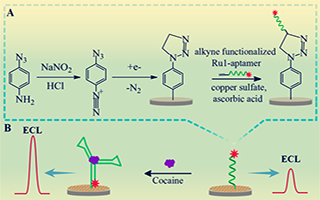

基于电化学双共价键法构建可再生高灵敏的电化学发光适体传感器检测可卡因
收稿日期: 2018-12-04
修回日期: 2019-01-15
网络出版日期: 2019-01-29
基金资助
国家自然科学基金项目(No. 21775097)和中央高校基础研究经费(No. GK201801006)资助
Sensitive and Reusable Electrogenerated Chemiluminescence Aptasensor Fabricated by Electrochemically Double Covalent Coupling Method for the Detection of Cocaine
Received date: 2018-12-04
Revised date: 2019-01-15
Online published: 2019-01-29
Supported by
We thank the National Science Foundation of China (No. 21775097) and the Fundamental Research Funds from the Central Universities (No. GK201801006)

王晓飞 , 张 婷 , 王 冰 , 漆红兰 , 张成孝 . 基于电化学双共价键法构建可再生高灵敏的电化学发光适体传感器检测可卡因[J]. 电化学, 2019 , 25(2) : 223 -231 . DOI: 10.13208/j.electrochem.181044

/
| 〈 |
|
〉 |